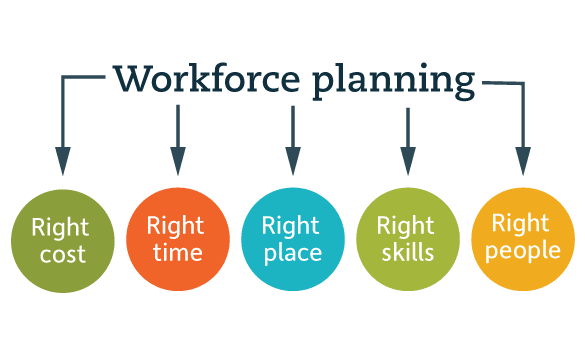You probably have a hiring plan. But do you conduct strategic workforce planning?
Many companies discuss staffing when it’s time to establish annual goals and set a budget. Perhaps the desire to increase profits in the upcoming year demands headcount adjustments, and so plans are made to grow or reduce staff, contractors or consultants.
But this staffing practice is shortsighted for two main reasons:
- The focus is usually short-term (one year or less).
- It doesn’t take into consideration outside and internal factors that may impact that narrow-focused approach.
That’s where strategic workforce planning comes in. Staffing plans are still needed but are only one piece of a broader strategic workforce plan.
Let’s explore the reasons why you may want to develop such a plan and how to create one for your organization.
What is strategic workforce planning?
Where a staffing plan addresses only one future-state scenario, strategic workforce planning may address multiple situations.
It uses a three- to five-year outlook instead of just a one-year view.
And because of the strategic emphasis, this type of workforce plan may be less detailed than a staffing plan, which usually has a more tactical focus.
Strategic workforce planning is about ensuring your organization will have:

- The right people
- With the right skills
- At the right place
- At the right time
- At the right cost
When these conditions are met, your workforce is poised to deliver on your business goals effectively for the long-term. But also, if any one of these factors is off, there is a negative impact to your organization’s ability to meet its goals.
That’s why strategic workforce planning is so important and can be so beneficial.
Now, here are the steps you can take to develop your own strategic workforce plan.
1. Discuss business strategy
Your organization must have a clear, shared vision of its long-term goals to have an effective strategic workforce plan.
To get there, develop your long-term business strategy by exploring where you want to be as an organization in five years.
Just make sure that all the right people are in the room. Human resources leaders are often left out of these conversations, but that’s a mistake because it’s your people who make your goals happen.
Offsite meetings are helpful to get into the right mindset (so you won’t be interrupted by the daily grind). Aim to specifically plot your company’s five-year goals.
Here are some great questions to ask your team:
- What is our strategic focus or desired future state?
- What do we want as a company five years from now?
- What is most important to successful execute the strategy?
- What will we have to stop, start or continue to get there?
- What do we have to do exceptionally well to win?
- What are the capabilities we need to perform at that exceptional level?
2. Perform a current-state analysis
Next, look at what you currently have – both people and skills. This is called a current-state or internal supply analysis. Look at your talent supply by job role rather than by person, as this helps you to be more objective.
Then, analyze what capabilities your people in those roles have right now against what you need them to be according to your business strategy.
To determine future talent supply, some organizations make projections based on historical turnover numbers or industry benchmarks. Companies with more resources may use predictive people analytics to identify certain risks like turnover and retirement.
3. Decide which roles are critical to current and future success
This may be the most difficult task involved in strategic workforce planning – deciding which are the key positions in your organization or those most crucial to moving toward your goals.
Remembering your key business objectives, ask yourself:
- Which roles (current or future) will disproportionately drive the success of the strategy?
- Which roles could be understaffed with little risk to our business?
- What jobs are most vital?
- What current or future skills will disproportionately drive the success of the strategy?
- What capabilities will accelerate our ability to deliver on our promise?
4. Analyze gaps and risks
If there’s a skills gap between what you have and what you think you’ll need, take time to explore all the ways you could close those gaps.
For example:
- Would it be best to train your people or plan to hire from the outside?
- If some of your people are nearing retirement, do you need to offer packages to get people to stay so you don’t lose their knowledge?
Also examine any external factors that may put your strategy at risk. Outside risks may arise from economic or political conditions, changes in the labor market, evolving industry trends or new legislation.
Your leadership team can work together to evaluate how to weigh these risks. Have everyone share their top three to five concerns. As a group, determine which are most relevant or potentially catastrophic. Follow up with scenario planning, and preemptively decide how to respond.
5. Develop an action plan
Looking again at your most critical roles and skills, start prioritizing and putting your action plan in place.
- Which roles and/or skill gaps present the greatest strategic risk to your success?
- What actions should you take regarding those roles and skill gaps that pose the greatest risk?
Use SMART (specific, measurable, achievable, relevant and time-bound) goals to focus your efforts. Continue following up to make sure it happens. If something changes or doesn’t go according to plan, see what you need to do to adjust.
Planning over plan
Creating an organization-wide strategic workforce plan is a sizable endeavor, so it can help to start small, develop a plan for one department to get more familiar with the process.
And remember, the plan itself is unlikely to unfold as you intended. After all, nothing in the future is certain no matter how thorough you’ve been.
In this case, going through the planning process is more valuable than the plan itself. Doing so will help your organization handle the unpredictable faster and better.
If you’d like to learn more about how to how to hire talented employees, read our complimentary magazine: The Insperity guide to attract, recruit and hire top talent.


